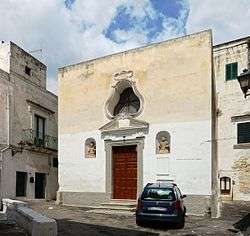Grottaglie
| Grottaglie | ||
|---|---|---|
| Comune | ||
| Comune di Grottaglie | ||
 Church of Madonna del Lume. | ||
| ||
 Grottaglie Location of Grottaglie in Italy | ||
| Coordinates: 40°32′N 17°26′E / 40.533°N 17.433°E | ||
| Country | Italy | |
| Region | Apulia | |
| Province | Taranto (TA) | |
| Frazioni | Carraro delle Vacche, Paparazio | |
| Government | ||
| • Mayor | Ciro D'Alò (Lista civica Grottaglie ON) | |
| Area | ||
| • Total | 102.12 km2 (39.43 sq mi) | |
| Elevation | 133 m (436 ft) | |
| Population (December 31 2014) | ||
| • Total | 32,114 | |
| • Density | 310/km2 (810/sq mi) | |
| Demonym(s) | Grottagliesi | |
| Time zone | UTC+1 (CET) | |
| • Summer (DST) | UTC+2 (CEST) | |
| Postal code | 74023 | |
| Dialing code | 099 | |
| Patron saint | St. Francis of Geronimo, St. Cyrus | |
| Saint day | January 31 | |
| Website | Official website | |
Grottaglie (Salentino: li Vurtàgghie; Latin: Criptalium) is a town and comune in the province of Taranto, Apulia, in southern Italy.
Geography

Grottaglie is located in the Salento peninsula, a whole rock of limestone dividing Adriatic sea from Ionian sea. The countryside around the city is scattered with vast and deep ravines that open the ground into the heart of the limestone-rock. The landscape is characterized by the presence of such ancient and enthralling rupestrian ravine encircling the built-up area. Source: Grottaglie.it - ProLocoGrottaglie.org.
History
The name Grottaglie derives from the Latin Cryptae Aliae, meaning "many ravines", which has been inhabited since the Palaeolithic Age. The ancestral part of Grottaglie was one of the citadels in the area, referred to in Medieval documents as Casale Cryptalerum, founded during the Dark Ages by the inhabitants of the caves who sheltered there due to Saracen invasions.
The fief of Grottaglie was donated by the Norman overlords to the archbishopric of Taranto in the 11th century. In the 14th century the ecclesiastic administration provided the fief with fortifications, walls, a castle (Castello Episcopio, Italian for “archbishop’s castle”) as well as with the Chiesa Matrice ("Mother church").
Since the 15th-17th centuries the jurisdiction over Grottaglie fief was split between the ecclesiastic administration (civil law) and the lay feudal lords (criminal law, Cicinelli-Caracciolo family). Fights between these two competing authorities and periodic revolts by the heavily-taxed population were the leit-motiv of Grottaglie’s history until the abolition of feudalism (1806). After the Italian unification Grottaglie had the first urban expansion outside its Medieval walls. Source: Grottaglie.it - ProLocoGrottaglie.org.
Main sights
- The massive Castello Episcopio (13th century) castle.
- The main church, also known as Chiesa Matrice, dating back to 1379.
- The city's oratory, known as Purgatory Oratory.
- Palazzo Cicinelli, a massive building on the main square later redecoreted to the current fashion during the Baroque period. The palazzo was the seat of the Dukes of Grottaglie also Princes of Cursi and Princes of the Holy Roman Empire, hence the residence of the feudal lords of the town on the grant of Bohemond I.
- Palazzo Urselli, which maintains the original Renaissance (pre-Baroque) façade, with a massive 15th century gate and a decorated internal courtyard.
- Palazzo Maggiulli-Cometa, whose structure is similar to Palazzo Urselli’s.
- Palazzo de Felice, an 18th Century palace, and ancestral home of the de Felice family.
- Monastery of San Francesco di Paola, representing the greatest Baroque monument in the city. It has a splendid cloistered-court inside.
- The Chiesa del Carmine, housing a 1530 stone crib scene made by Stefano da Putignano.
- Source: Grottaglie.it - ProLocoGrottaglie.org.
Culture
Folkloristic and religious events include the commemoration-day of St. Cyrus and Easter-period when the Medieval-rooted confraternal religious orders perform their processions during the days of the Holy Week (Easter rituals include procession and pilgrimage of confrères called “Bubble-Bubble” through the streets of country).
Other events include:
- The exhibition “Ceramica nel Quartiere delle Ceramiche”
- The Mediterranean ceramics contest, theatrical and musical events
- Promotion of dessert grapes, months of July–August–September
- Exhibition-contest about ceramic crib scene during the months of December and January
- “Musica Mundi” – international festival of ethnic music in July.
- Source: Grottaglie.it - ProLocoGrottaglie.org.
Economy
Grapes and ceramics-industry are two traditional elements of the local economy since the times of Greater Greece.
The numerous ceramic finds, tracing back to the Classical Age and kept in the National Museum of "Magna Grecia" in Taranto, reveal the antique roots of this handicrafts production which was privileged by the presence of considerable amounts of clay in the surrounding territory. More recently, records dating back to the 18th century report at the time 42 companies in Grottaglie operating in the ceramics-sector with a total of 5,000 employees. In addition to ceramics, also agricultural products such as olive oil and excellent choice dessert grapes are of great importance.
Alenia Composite is a factory of Alenia group producing parts for the Boeing 787.
Source: Grottaglie.it - ProLocoGrottaglie.org.
External links


